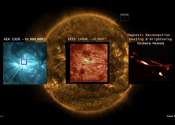Study finds meteoric evidence for a previously unknown asteroid
A Southwest Research Institute-led team of scientists has identified a potentially new meteorite parent asteroid by studying a small shard of a meteorite that arrived on Earth a dozen years ago. The composition of a piece ...









